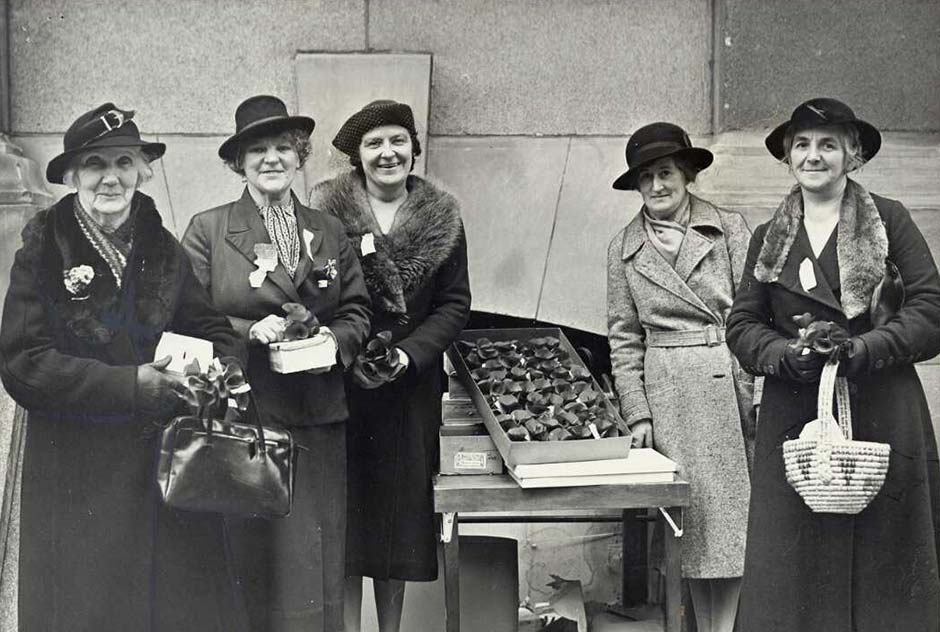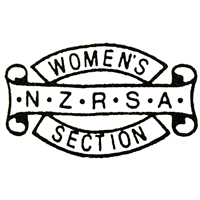This essay written by Bronwyn Dalley was first published in Women Together: a History of Women's Organisations in New Zealand in 1993. It was updated by Stephen Clarke in 2018.
1941 – 1993
In keeping with their motto of 'People Helping People', the women's sections of the Royal New Zealand Returned Services' Association (RSA) offered a range of welfare and support services to members of the RSA and the wider community. While each women's section had its own administrative structure, all sections were subject to the local branch of the RSA to which they were affiliated. There was no national executive or organisation of the women's sections; any nation-wide co-ordination was carried out by the RSA.
In 1992 there were women's sections in all of the 270 branches of the RSA, and women comprised a substantial proportion of the approximately 28,000 members listed as belonging to either women's sections or local RSA clubs. Membership of the sections was open to all 'near relatives' – specifically wives, widows, mothers, sisters and daughters – of all current or past members of the New Zealand armed forces, including military nurses, members of Voluntary Aid Detachments (VADs) and women's auxiliaries. Women who had themselves served overseas as nurses, VADs or in any other service capacity were also entitled to join, though some preferred their own organisations.
The women's sections of the RSA, in their 1990s form, dated from the middle of World War II. The first section appears to have been Kaiapoi, formed when a group of women met in the local RSA hall on Waitangi Day, 1941. Others followed quickly: by March 1942, both the Napier and Wellington RSA women's sections were holding meetings. In that year, the RSA publication Review noted that 'Women's Sections of the RSA are being formed in all parts of the Dominion and are performing useful service to the Associations'. [1]
Yet the services provided by women's groups within the RSA predated the war years. Ladies' committees had been an established part of the RSA since the first was formed in Hokitika in 1919, three years after the formation of the RSA itself. The growing activity of women within the RSA was recognised in principle in 1930 when the Review included a special section for women. The space was not, as the editor was at some pains to point out, a 'Ladies' Column', but an opportunity for women to send in their favourite recipes.
During the 1920s and 1930s, the ladies' committees had three main functions: organising annual Christmas parties for children, fundraising, and taking responsibility for Poppy Day. Each was a major undertaking for the women concerned. The Christmas party in Wellington in 1935, for example, attracted 1200 children. The same committee was involved in the manufacture of 20,000 flowers for Poppy Day the following year. In 1930 the Hutt Valley branch of the RSA acknowledged the work of the ladies' committee: 'One can never grow tired of singing the praises of that little band of Ladies who work unostentatiously to help us in any way they can, and it is from them that the ideas and schemes for raising money generally originate.' [2]

Alexander Turnbull Library, EP-Days of Commemoration-ANZAC Day-05.
Women selling Anzac poppies, Wellington. When this image was published in 1940 it referred to these five women as 'Veterans of Poppy Day', as they had been selling poppies in the streets of Wellington since the first New Zealand Poppy Day in 1922.
During World War II the activities of the ladies' committees altered and expanded dramatically. Very quickly, the committees added a broad welfare role within the RSA and the community to their regular responsibilities. They organised a range of entertainments for men about to depart for the war, and ensured that holidays and accommodation were available for their families. Members also took a very active role in visiting and providing for those women whose relatives were killed in action or held as prisoners of war. The committees worked in close conjunction with other women's organisations in the community, visiting hospitals and organising sewing and knitting for those serving overseas.
The increased responsibility of the ladies' committees led to their evolution into the more formalised women's sections, a move validated by the Dominion council of the RSA in 1942. There was evidently some initial resistance to the transition. At a meeting of the Gisborne RSA and RSA Ladies' Social Committee in June 1942, some women expressed a degree of anxiety over forming a women's section, questioning the role it would play. Within a short time, however, the women found 'a wide field of useful activity on behalf of service people and their dependants'. [3] The section, which attracted over 200 members, arranged accommodation for both Māori and Pākehā servicemen who were on leave, and also extended their services to assist others in need.
By the end of the war there were more than fifteen women's sections throughout the country, and the number increased steadily in the immediate post-war years and through the 1960s. Women's sections continued to provide welfare services for ex-servicewomen and men and their dependants, in addition to the traditional functions of organising Poppy Day and fundraising. While these responsibilities remained important, by the 1990s the sections had also become more active in wider community ventures such as catering and fundraising for hospices or creches; in a sense, this represented a continuation of the traditional activities of the early ladies' committees.
Bronwyn Dalley
1994 – 2018
After 1993 the women’s sections continued to experience growth alongside RSA membership nationwide, with many reaching retirement age, and peaked in 2001 at 16,700 members spread across 133 women’s sections. [4] That year, the national RSA body recognised their history and support over the past sixty years by presenting each women’s section with a certificate of appreciation, in recognition of the International Year of Volunteers.
In the early 2000s came calls for greater coordination of the women’s sections across the country. The RSA’s National Women’s Association (NWA) was formed as an incorporated society in 2006, with its own officers, accounts and an annual general meeting. The latter was opened each year with the traditional song ‘Lend a Hand’ – this new body was not going to threaten the RSA male establishment. Nevertheless, the RSA only reluctantly allowed the NWA president to sit on its national executive – only the second woman at that time to do so since 1916. The NWA also had to overcome opposition from women’s sections themselves, which had only ever owed allegiance to their own local RSA.
Slowly, however, women’s sections began to join the NWA (in 2018 there were 50 women’s sections affiliated, with 3000 members) as they realised that they faced similar challenges, and saw value in the national coordination of campaigns, such as support for the Cancer Society’s pink ribbon breast cancer appeal.
In 2018 the heart of the women’s section movement still remained at the local level, where they continued to assist with hosting RSA club functions, including funerals, and supporting the local poppy appeal. Women’s sections had by then largely relaxed the traditional criteria of members having to be siblings and widows of servicemen – in an era when women were making up a growing proportion of the New Zealand Defence Force. Some women’s sections also managed to attract younger members; but others had closed, due to their aging and declining membership. In 2010 (the latest year for which national figures were available) there were 10,600 members spread across 118 women’s sections. [5]
Stephen Clarke
Notes
[1] Review, Vol. 18 No. 2, March 1942, p. 29.
[2] Review, Vol. 7 No. 2, November 1930, p. 24.
[3] Review, Vol. 19 No. 5, September 1943, p. 14.
[4] Royal New Zealand Returned Services’ Association Annual Report, 2002
[5] Royal New Zealand Returned and Services’ Association Annual Report, 2011
Unpublished sources
[Most records held by individual RSA Women's Sections]
Masterton RSA Women’s Section records, 1945–1990, Wairarapa Archives
McLean, C.R., 'The Dunedin RSA (lnc): An account of events leading up to and following the establishment of the Association and the erection of its club', Dunedin, 1959, in possession of Dunedin RSA
'Rules of the Taumaranui Returned Services' Association (Women's Section) Incorporated' (pamphlet) [n.d.]
Wellington RSA Northland Branch Women's Division records, 1942–1977, ATL
Published sources
Clarke, Stephen, After the War: The RSA in New Zealand, Penguin, Auckland, 2016
Ebbett, Eve, When the Boys were Away: New Zealand Women in World War II, Reed,
Wellington, 1984
RSA Review, c. 1924–2018
Women's War Service Auxiliary, A Review of the War Years 1940–1946, WWSA, Auckland, 1946


Community contributions